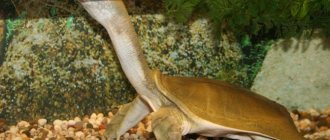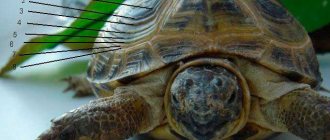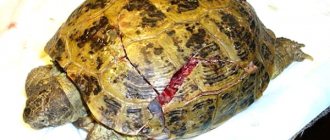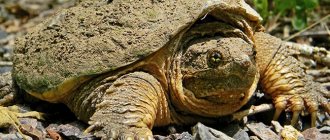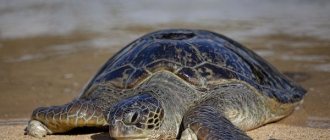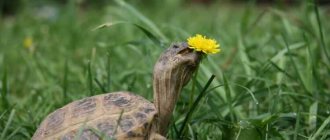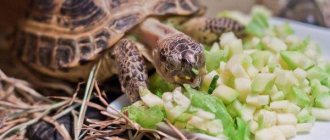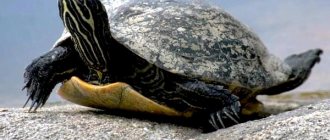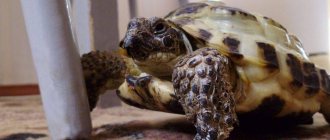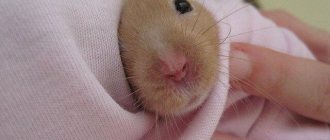Since childhood, we have associated the image of a turtle with two of the cutest representatives of this type of reptile - Tortila with her golden key and the Turtle, who in the famous cartoon sang a duet with the Lion Cub a song about “I’m lying in the sun...”
Maybe that's why these exotic animals are readily kept as pets. Children especially love them. Turtles have an extremely calm, accommodating disposition, and their appearance is quite attractive. They do not require special care.
However, like any living creature, problems may arise that will cause panic among the owners of the “tortillas”. In particular, they can be so connected with the shell that they can tell a lot about the state of health of the reptile.
Features of caring for a turtle during molting
During the molting process, it is necessary to provide your beloved reptile with all comfortable conditions.
The turtle's daily routine should remain unchanged, but the diet requires special attention. In order for the reptile to replenish the reserves of vitamins it needs, you should give your pet crustaceans and fry to eat. You can also purchase special vitamins designed for young turtles.
You also need to pay special attention to the cleanliness of the reptile’s home. Since it is during the period of skin exfoliation that there is a lot of contaminants in the aquatic environment in the form of tissue particles, which must be gotten rid of
To avoid rotting of dead layers, you need to frequently replace the water and monitor its cleanliness.
Sometimes the owners decide to provide some kind of help to get rid of unnecessary parts of the body. This should only be done in extreme circumstances, namely if part of the skin has not completely peeled off and is greatly bothering the turtle. You can also help your pet and run a toothbrush over the shell, thus ridding it of the excess layer. If you do not pay any attention to the remaining tissue, the reptile may succumb to illness or harm itself while trying to remove unnecessary parts.
Diet and hygiene
Pay special attention to feeding. There is no need to completely revise the diet, but you should add foods containing calcium - shellfish, shrimp, lean fish, crushed eggshells, bone meal. Vitamins that can be purchased at a pet store will not be superfluous.
Clean the aquarium in a timely manner and monitor the condition of the water. Dead particles of a turtle shell accumulate on its surface, polluting and creating favorable conditions for the proliferation of all kinds of microorganisms. It is advisable to change the water more often during molting to prevent the turtle from getting sick.
Diseases in which the skin peels off
It is normal for a reptile's skin to peel and flake off during the molting period. As soon as the animal is raised, everything is over.
But sometimes peeling skin can be a sign of pathology.
The clinical picture of the following diseases resembles the molting process:
- Mycosis. Most often, a fungal infection develops in the spring, when the animal’s immunity is weakened, especially if it hibernated. With this disease, you can notice a white coating on the skin, which can be easily removed with a cotton swab. If the animal moves and touches various objects, then white stripes remain on them.
- Rickets. With this pathology, the shell becomes bent and may begin to peel off. The eyes may become swollen, causing them to close completely. Due to the curvature of the jaws, the turtle does not eat anything, which can cause death.
- Hypovitaminosis. If an animal’s diet is monotonous and it does not receive all the necessary vitamins, then it may develop vitamin deficiency. Hypovitaminosis A is manifested by peeling of the skin. There is desquamation of large scutes on the limbs and head, marginal blepharitis, in which the eyelids swell, and the cloaca prolapses. The reptile grows a “parrot-like” beak. Often, with hypovitaminosis A, a runny nose is observed, so the disease is confused with a bacterial infection. Also, the animal may not eat anything, which will cause the reptile to become exhausted. To prevent the development of vitamin A deficiency, the pet must constantly receive liver, fish entrails, carrots, and pumpkin.
To exclude these pathologies, it is advisable to show your pet to a herpetologist, who, if necessary, will select adequate therapy.
If this is not possible, then you should carefully examine the reptile. When the animal is active and does not exhibit any alarming symptoms, then most likely the peeling and detachment of the skin is associated with molting and there is no cause for concern. This means that the red-eared slider is developing correctly.
How red-eared turtles molt
And if not molting, then what?
Deformation of the shell during rickets.
However, the symptom of turtle shell peeling may indicate other, more serious reasons not related to molting:
- vitamin A imbalance,
- fungal diseases,
- rickets.
The first ailment is characterized by the formation of ulcers, very severe peeling or flaking of the skin. The scutes peel off from the shell (this does not apply to decorated turtles), and even quite large pieces come off.
An indicator of a fungal disease or dermatitis can be prolonged molting. In an amphibian, the scutes are not completely removed, but under them or on the skin of the animal, areas and sores with a pinkish tint form. White spots appear on the shell of a sick animal. The skin in the folds exfoliates and flakes, causing swelling and pimples. The turtle is suffering from severe itching.
Prevention measures
Any disease is easier to prevent than to treat. Turtle shell problems are no exception. To avoid them, provide your reptile with adequate nutrition. The menu should consist of food of animal and plant origin.
Buy a UV lamp and give your turtle irradiation sessions to produce vitamin D in its body, which facilitates the absorption of calcium. In summer, take your turtle outside for walks. At the same time, make sure that the animal does not come into direct sunlight.
Pay attention to the water you fill the aquarium with. Its excessive rigidity can negatively affect the condition of the shell
This water must be filtered.
In addition, tap water contains chlorine, which causes certain diseases. Let it sit for a day before pouring it into the aquarium so that the harmful impurity has time to evaporate.
Disease Prevention
Diseases of red-eared turtles often lead to sad consequences, so the best way to cure your pet is to prevent the development of diseases. To avoid problems, you need to follow the recommendations of experienced owners:
- The terrarium is constantly cleaned and water replaced.
- Turtles are provided with a balanced diet containing vitamins and calcium.
- Before serving vegetables and herbs, the products are processed.
- The terrarium is provided with good lighting, which is necessary for turtles, and ventilation.
- Before new neighbors or decorations are placed, they are checked for diseases and bacteria.
- The required water temperature is maintained in the terrarium.
Red-eared turtles are cute and funny pets that, if properly maintained, can delight their owners for decades. To avoid the development of dangerous diseases, you should carefully take care of the animal, following the rules and care and recommendations of qualified specialists.
Actions of the owner upon detection of symptoms in the animal
When the first signs of disease are detected in red-eared turtles, it is necessary to take the animal to a veterinarian for diagnostics and an accurate diagnosis. It is recommended to take the following actions to change the living conditions for a sick animal:
- For a sick turtle, raise the temperature in the aquarium to improve the animal’s immunity;
- maintaining fluid balance; dehydration of the turtle’s body should be avoided;
- It is advisable to reduce the volume of water in the aquarium so that a sick animal cannot drown.
When keeping several individuals of red-eared turtles at home, it is necessary to immediately, if symptoms of a fungal infection are detected, place the healthy animal in a separate aquarium to prevent its infection.
When a fungal infection appears in the house, it is necessary to disinfect the areas where the turtle is kept:
- Irradiation of the aquarium with ultraviolet light for 2 hours from a distance of no more than 1 meter;
- washing the aquarium with soapy water;
- It is mandatory to treat the aquarium with a 1% chloramine solution with the addition of a 10% bleach solution, followed by rinsing the aquarium 2 hours after treatment;
- replacing aquarium soil with fresh one;
- get rid of animal excretions and food debris by disinfecting them with a bleach solution and subsequent disposal.
If an animal becomes ill, disinfection of its place of residence must be carried out regularly at least once a week.
Health and illness
Animal health is 90% determined by compliance with the rules for the care, nutrition and maintenance of turtles in a home aquarium.
Tips for keeping your animal healthy:
- for sick turtles, the temperature is raised to 27–30 degrees (for immunity);
- maintain fluid balance, avoid dehydration (the turtle should be in water, drinking);
- for a sick animal, reduce the water level in the aquarium so that it does not drown (if the turtle is a poor swimmer, it should be able to freely go ashore);
- If you suspect an infection, isolate the animal and wash your hands after contact;
- do not self-medicate, seek help from a veterinarian-herpetologist.
Hibernation
In nature, hibernation is a reaction to unfavorable environmental conditions, cold and heat. Such sleep for animals helps to survive these periods.
At home, where they are comfortable, there is no need to hibernate. Don't stimulate hibernation!
Walks
Take turtles outdoors so they get natural sunlight. Take it out into the courtyard of a house in the city, take it with you to your summer cottage.
For a walk, try to choose dry, sunny, windless, warm weather. At temperatures below 25 degrees and in other weather conditions, it is better to keep the animal at home.
Take your pet to a clean, quiet area with some shade and vegetation. She will happily eat fresh clover, plantain, and dandelion.
At your dacha, build a special pen for walking for a land turtle, and a private pool for an aquatic turtle.
When walking, provide constant supervision to the animal so that it does not eat anything harmful, does not get hurt, or runs away. Protect it from insects, animals, birds, children, from overheating and cooling.
When you get home, check your pet for any wounds or contamination. If they are very dirty, wash them.
Causes of fungus in red-eared turtles
As a rule, mycosis in a red-eared turtle is a secondary disease that occurs against the background of pneumonia, stressful situations and a lack of vitamins in the pet’s diet. In addition, mycosis can develop if certain rules for caring for a turtle are not followed:
- Reduced water temperature;
- insufficient size or complete absence of an island of land in the recreational aquarium;
- lack of an ultraviolet lamp for heating the animal;
- long-term use of drugs to treat other diseases;
- incorrect diet.
A humid environment is considered favorable conditions for fungal growth. During molting periods, turtles are most susceptible to fungal infections. To prevent possible infection, the animal needs to go ashore more often under artificial lighting.
There are two types of fungus in the red-eared slider, the main of which is considered to be superficial mycosis that affects the shell and skin. The second type of fungal infection is deep mycosis, which affects internal organs. This type of disease is much less common and difficult to diagnose due to symptoms similar to similar diseases caused by bacteria.
Causes of the disease
Detachment and rotting of the turtle shell and the formation of ulcers can occur due to the following reasons:
1. Fungal (mycotic) infection. Characterized by mild inflammation and stench. However, fungal infection is more dangerous than microbial infection. This is due to the absence of clinical manifestations of the disease.
Fungi are a possible cause of extensive damage to the shell.
Factors predisposing to the development of a fungal infection in the shell are injuries, malnutrition, an immunosuppressive state, hypothermia, lack of essential vitamins and microelements, etc.
2. Bacterial damage.
The cause of this pathology is gram-negative anaerobic bacteria. Weakened turtles are susceptible to this infection.
A layer of necrotic and purulent masses forms in the area of damage to the shell. This helps create conditions for further proliferation of microbes. Pus has a very foul odor.
Prevention methods
There is one truth that must be adhered to. She claims that it is easier to prevent a disease than to treat it. Therefore, in order not to have to undergo treatment, it is better to regularly carry out preventive measures, which is what experienced owners do. This is especially true when the animal has gastrointestinal disorders or the turtle has contracted an acute respiratory infection and its body spends a lot of energy fighting these ailments.
Prevention is carried out every few months, or maybe more often, depending on the conditions. As a preventative measure, you can use oak bark baths or etch the aquaterrarium with Methylene Blue.
Carrying out preventive measures does not in any way indicate that there is no need to keep the animal in normal conditions. Normal conditions are appropriate temperature conditions, cleanliness and an appropriate diet. Without these three components, it is unlikely that it will be possible to raise a healthy animal. After all, in addition to fungus, pets are also plagued by other, no less serious diseases. All of them are directly related to both nutrition and living conditions.
Fungus in the red-eared slider is the most common disease in this species of animals at any age.
Caution should be exercised when handling an infected animal due to the risk of possible infection to humans upon contact. Turtles living in the wild are not susceptible to fungal infections.
Most likely, when pets get into home conditions, they lose the protective properties of the body.
Treatment of fungus in a turtle at home
Treatment of fungus in a red-eared slider takes about a month. An integrated approach using various drugs is used for treatment. In addition, it is necessary to keep an ultraviolet lamp on around the clock, the rays of which have a detrimental effect on pathogenic microorganisms, including yeast fungi.
Aquarium water
When treating a fungal infection, the aquarium water should be heated to a temperature of 22 to 26 degrees, due to the fact that warmer water promotes accelerated growth of the fungus. It is necessary to add methylene blue crystals to the water for a month for disinfection. Change the water in the aquarium weekly, followed by disinfection of the aquarium itself.
Pharmacy drugs
| Type of drug | Name | Application |
| Injections | Baytril, Marfloxin | course of injections daily for 10 days |
| Ointments | Triderm, Terbinofin, Akriderm, Nizoral | course of treatment is 14 days with use at night. The animal must be in a dry place |
| Baths | Betadine | daily 30 minute baths for 14 days |
Traditional methods of treatment
In addition to the main set of treatment procedures, you can use traditional medicine methods when treating fungus in turtles to speed up the healing process.
For treatment, an infusion of oak bark similar in color to brewed tea can be used. Daily baths lasting about an hour are taken with this infusion. Such baths have an antiseptic and healing effect.
A whitish coating on the shell in the initial stage of the disease can be eliminated by bathing the turtle for 30 minutes in a solution of 2 teaspoons of salt in a liter of warm water for 15 days. During the procedure, you need to monitor the pet's behavior.
Treat fungal-affected areas with a 1% solution of potassium permanganate for 3 days.
Diet
A sick pet needs to strengthen its diet by adding a large amount of vitamins and mineral supplements, as well as protein foods.
The following foods should be included in your turtle's diet:
- raw lean fish and unrefined seafood;
- dandelion leaves, various seaweeds and vegetables;
- live food from earthworms, small fish and insects;
- You can use a gelatin-based feed mixture with vegetables, milk and raw eggs.
It is not recommended to use for food:
- fatty types of meat and fish;
- porridge, cheese, bread, cottage cheese, boiled or fried foods;
- parts of poisonous and alkaloid-containing plants.
Bone (shell) diseases
The main symptoms in this case are softening or peeling of the shell. This can occur both due to a lack of ultraviolet radiation (artificial or natural), and due to a lack of calcium in the body. In baby turtles, shell abnormalities indicate the presence of rickets. Detachment of the scutes is also possible when infected with a fungal infection.
In order to prevent softening of the shell, it is necessary to irradiate the terrarium with a special ultraviolet lamp at strict intervals. By the way, similar devices for terrariums from the German company Hagen have proven themselves to be quite good. It is also necessary to eat chopped fish with bones (it is advisable to grind the bones) to supply the body with calcium.
Fungal disease of areas of the shell is easy to identify. Under the peeling shield, brown crusts and a gray coating are visible.
This case is treated by daily washing the affected area with a solution of methylene blue for 30 days.
In more complex cases (ulcers and even blood stains are visible under the shield), it is recommended to use clotrimazole medicinal ointment. The ointment is applied to the affected area in the evening, and the patient is left on dry land overnight. During the day, you need to carry out the washing procedure in a blue solution.
Fungus treatment
It is quite easy to rid a turtle of a whole “bouquet” of infectious diseases if you follow the appropriate recommendations.
- Since there are several types of microbiotics for fungal infections, only a specialist can determine an accurate diagnosis. To do this, you will have to take a blood test and a smear. Only based on the test results can a conclusion be made about the type of fungal disease.
- Regardless of what kind of fungus the turtle has, it is necessary to completely disinfect the aquaterrarium, as well as the objects inside it.
- If several individuals are kept, the sick turtle is removed until the disease disappears. The turtle can be cured in two weeks or 2 months, depending on the severity of the disease.
- You need to add Methylene Blue to the water. Its quantity is selected so that the water is slightly colored and has a slightly bluish tint. If the aquaterrarium has a carbon filter, then it is better to turn it off, otherwise the effect of the drug will be neutralized.
- A sick turtle undergoes preventive and therapeutic actions. To do this, it is placed in a bath with oak bark tincture for 1 hour. This procedure is carried out daily until the fungus completely disappears. The color of the liquid should match the shade of regular tea. In severe cases, the concentration of oak bark can be increased.
- The turtle should be irradiated daily with a UV lamp. This radiation (ultraviolet) can destroy the infection.
- In addition to the above measures, the use of ointments is required. Ointments such as Triderm, Terbinofin, Akriderm and Nizoral are suitable for this. The turtle is smeared overnight, leaving it in a dry, warm place.
- In parallel with the treatment procedures, the sick turtle is prescribed a diet rich in vitamins and nutrients.
As a rule, such instructions refer to the main treatment regimen, although treatment with other methods is also possible. In any case, it is better to consult a veterinarian and not start self-treatment, which can lead to unpredictable consequences.
How not to get confused?
Many turtle owners consult a veterinarian when they begin to shed. And this is not surprising, since many diseases have symptoms similar to molting processes. Such diseases include: fungus, which can result in parts of the skin peeling off, rickets, which leads to curvature of the shell and, as a result, detachment of its parts. If your diet includes insufficient amounts of vitamins, this can also lead to flaking of the skin.
If it is difficult to determine the cause of peeling skin, it is better to contact a veterinarian, he will tell you exactly what the reason is. Unfortunately, this is not always possible; then you need to be guided by the following considerations. If peeling is detected, you should observe the pet's behavior. As a rule, most diseases are accompanied by general depression of the turtle’s body. If nothing has changed in the reptile’s behavior and it leads an active lifestyle, then most likely it is molting. In this case, there is reason to be in a good mood, since the reptile is growing and developing as it should be and there is no reason for concern.
If the turtle refused to eat and stopped behaving actively, then in any case, whether you want it or not, whether there is an opportunity or not, it is better to show the pet to the veterinarian. Ignoring this kind of behavior can lead to disastrous results, that is, you can lose the turtle. The appearance of any disease indicates that the animal has received little attention and is growing in conditions where there may be a lack of nutrition or sanitary conditions may be better. In this case, the attitude towards a living being needs to be changed towards improvement. First of all, you should decide on the diet and duration of receiving UV-van. Without these two components, it is unlikely that a small turtle will grow into an adult.
Feeding
The issue of preparing your pet’s diet must be approached very responsibly. Very often, incorrectly selected food provokes red-eared turtle disease.
In an aquaterrarium, the diet of red-eared turtles should include small crustaceans (gammarus or shrimp). Your pet will not refuse small aquarium or river snails. You can finely chop ocean fish, meat, and liver.
Owners are often interested in the question of what diseases red-eared turtles carry. It should be noted that most pathologies are associated with the condition of the shell - softening, delamination, etc. This is often observed with a lack of calcium. To avoid such problems, it is necessary to include in the animal’s diet foods rich in this element - fish heads, bone meal, eggshells, chalk.
We must not forget about useful supplements in the form of plant foods. Turtles enjoy eating leaves of cabbage, dandelion, spinach, plantain, and lettuce. Among the algae, they will like elodea, duckweed, seaweed, edogonium, anacharis, and water beetle. Young turtles should be fed twice a day. Then they are transferred to a single meal. Reptiles over two years of age are fed no more than three times a week.
The molting process in turtles
The red-eared slider molts at a young age, when its body is forming and growing. This is due to the fact that the layer of shell and skin that is on the surface progresses at a slower rate than the reptile’s body, which in turn leads to its rejection. In fact, the molting process does not pose any threat to the reptile, since it is natural in the life of the red-eared turtle
However, it is worth considering that during this period of its life, your beloved pet most of all needs your attention and proper care
To understand why the red-eared slider molts, you need to study some information on its structure.
When individuals begin to develop intensively, the layer of skin and shell peels off and looks like a continuous film, which in turn can remain on the surface of the water in the aquarium for a long period of time. With each stage of maturation, molting in a turtle occurs less and less often, and only some particles of the surface layer can be peeled off. Consequently, the process of molting in turtles is a completely natural stage of development, and ends when the individual has reached adulthood.
It's easier to warn...
Spots on the shell.
And a few more “preventive” tips.
Proper feeding is largely the key to turtle health. This reptile should have both animal and plant food on the “dining table”. Exclusively meat products on the menu can provoke the occurrence of vitamin A deficiency and rickets. The turtle's diet should be varied: vegetables and fish, fruits and berries.
Spots on a turtle's shell can appear due to excessively hard water, so before adding it to the aquarium, the liquid must be carefully filtered.
In addition, tap water is often disinfected with chlorine, which can also cause a number of diseases. The water in the aquarium should be changed only after settling for a day. During this time, the gas will evaporate.
Silent pet turtles are unable to tell their owners about their poor health. It is possible to determine that they are unwell only by their appearance and changes in behavior. One of the important clues about a pet’s well-being is the appearance and condition of its shell. Any responsible owner of a cute reptile should be aware of what "turtle armor" can tell you.
Other interesting articles
- The red-eared turtle has a swollen paw, what to do. Owners of land turtles quite often encounter problems with swollen paws and joints. Most often they suffer...
- White film on the eyes of a land turtle The eyes are a fairly serious organ of turtles that have minimal protection from the influence of harmful bacteria,…
- Why does the red-eared turtle change the color of its shell? Red-eared turtles are very bright and stylish pets. Many owners purchase unusual exotic animals...
Signals of health problems
A young red-eared turtle molting is completely normal. It indicates good growth and harmonious development. If the shell begins to peel off in an adult pet, this is a sign of health problems.
For example, a turtle does not receive the required dose of ultraviolet rays. This is fraught with vitamin D deficiency, which can provoke peeling of the shell and its softening.
The presence of pathology also signals a lack of calcium in the reptile’s body. Among other things, its deficiency threatens rickets, a disorder of bone structure.
The causes of detachment and rotting of the shell, accompanied by the appearance of ulcers and an unpleasant odor, can be fungal or bacterial infections. They usually affect weakened turtles, lacking vitamins and microelements, and receiving insufficient nutrition. In addition, fungi and bacteria can settle in a damaged shell.
As a rule, peeling, peeling and softening of the shell are accompanied by such signs of a painful condition as lethargy, redness and swelling of the eyes, and high fever. If you notice them, take your pet to the veterinarian. The sooner the pathology is identified and treatment is started, the better.
If the vet is out of reach...
Fungus
Having noticed that the turtle has begun to molt, the owner should examine it and observe carefully. If, in addition to detachment, no other deviations from the norm are identified, the animal behaves actively, there is no reason for concern.
Having discovered that the shell is peeling off very much and even crumbling, you should resort to special treatment, which is prescribed based on the diagnosis. (The symptoms of various “shell troubles” were discussed above).
Pharmacies sell antifungal drugs Nizoral or Lamisil. They should be used to lubricate the damaged areas of the shell at night for two weeks, having first very carefully cleaned off the exfoliated tissue.
The fungus can cause irreversible degeneration in the tissues of the turtle “armor”. Such tissues must be carefully cleaned and BetaisodonaR ointment applied to the ulcerated area.
In the case of a fungal disease, “therapeutic baths” are recommended for the amphibian - bathing in chamomile decoction, a weak solution of potassium permanganate or malachite greens. The latter, by the way, is used to disinfect aquarium water.
The disease in its unadvanced stage can be treated quite successfully. If the fungus reaches the internal organs, it can cause the death of the animal.
The shell of a land turtle can peel off as a result of dehydration. In this case, daily bathing of the animal is recommended.
As for rickets, which, as we found out, is the result of a deficiency of vitamin D and calcium, here we are most likely talking not so much about the treatment of the disease, but about its prevention.
In the autumn-winter period, turn on the UV lamp.
So, in the warm season, it is recommended to take the aquaterrarium with the turtle out into the fresh air, while protecting the reptile from direct rays of the daylight.
In the autumn-winter period, the dwelling with the amphibian must be placed under a UV lamp three times a week - literally for five minutes.
Before the procedure, it is recommended to cover the turtle’s eyes with a plaster so as not to harm the lens and retina.
To replenish the level of calcium in the reptile’s body, shrimp rich in this element will not be superfluous in its menu. Since this pleasure is not cheap, you can treat your pet with fish and bones instead. Bone meal, crushed egg shells, and chalk are very useful.
If the disease is advanced, the veterinarian, as already mentioned, will prescribe vitamin injections.
How red-eared turtles molt
How does a red-eared turtle molt and why does it happen?
Many reptile owners are often not even aware of the phenomenon of molting red-eared turtles. Yes, the red-eared turtle sheds, and it does so quite often. In order to help your pet properly shed layers of shell and skin, you need to be able to ease the molting period and properly care for your pet.
How does shedding occur?
If you didn't know that reptiles can shed, you're probably wondering how red-eared sliders shed. This process occurs during active growth of the body, when the pet is quite young. The fact is that the upper layers of the skin and shell simply do not have time to grow after the body itself, as a result of which they peel off. There is no need to be afraid of this; molting does not pose any danger to either you or the turtle. This is a natural process provided by nature
However, you should remember that during the shedding period, your pet needs increased attention from you. In the early stages of development, the layers of skin and the upper layers of the shell peel off as a complete film, which can float on the surface of the aquarium for quite a long time
As the reptile ages, the amount of dead tissue decreases, and during the last moults of the reptile, only some areas of the skin and small pieces of the shell peel off. If you notice that your red-eared slider is molting, there is no need to worry about its health - when the animal grows up, this process will stop.
Juvenile red-eared turtles molt quite frequently. They can molt twice in a month. As a rule, frequent peeling of the skin and upper layers of the shell indicates the active growth of the pet. The total length of molting can reach several years - until the pet finally matures.
How to care for a turtle during the molting period?
If you notice that your red-eared turtle is molting, immediately take steps to provide it with suitable conditions.
There is no need to change your pet's daily routine - pay attention to the diet. As a rule, during the period of active growth, reptiles need large amounts of calcium and various vitamins
To replenish the body with calcium, you can give the turtle fry of fish or small crustaceans. You can also use special vitamin complexes that are designed specifically for young individuals.
Pay attention to the contamination of the aquarium in which your pet is located. If you understand how a red-eared turtle molts, you should have realized that during the molting period, many dead layers of skin and shell remain in the water
Consequently, the water will become polluted faster. Dead particles must not be allowed to rot. You just need to change the water more often to keep it clean.
In addition, some owners make attempts to help the turtle get rid of dead tissue. This can only be done in extreme cases, when you see that the layers of skin do not fall off for a long time and cause discomfort to the pet. You can use a toothbrush and gentle movements to help your pet get rid of dead tissue. If you do not pay attention to the remaining pieces of skin for a long time, the animal may get sick or scratch its skin in an attempt to get rid of the shed part of the body.
How not to get confused?
When a red-eared slider molts, many reptile owners get terrified and take the animal to the vet. Many diseases of red-eared turtles are similar in symptoms to the molting process. For example, a fungus causes the skin to peel off, rickets in turtles can cause the shell to bend or parts of it to peel off, and a lack of vitamins leads to exfoliation.
In order to completely eliminate the possibility of the disease occurring in your pet, a visit to the veterinarian is necessary. Only a specialist will be able to properly examine the reptile and give valuable recommendations on how to care for it. If you do not have the opportunity to visit a specialist, you can get rid of suspicions yourself. If you notice that your red-eared slider is molting, inspect the animal carefully. If you have not identified any other deviations from the normal state of your pet, and he is active and cheerful, you don’t have to worry. Remember only one thing - molting is permissible when the turtle’s body is developing, that is, during its maturation.
If your red-eared slider is shedding, you can rejoice! This only means that your pet is developing and growing. Soon, instead of a small turtle, there will be a full-fledged representative of reptiles in your apartment, delighting you with its fun games!
Signs and frequency of shedding
The red-eared turtle sheds during the period of active growth, when the reptile is still young. This is due to the fact that the upper layers of the skin and shell grow slowly, and they do not keep up with the growth of the turtle’s body itself, as a result of which they peel off.
This is a natural process, it is not dangerous either for people or for reptiles.
But you need to remember that during molting the animal needs special care.
While the reptile is young, its skin and the upper layers of the shell peel off as an almost complete film. She can swim on the surface of the aquaterrarium for quite a long time. But with age, the number of dead cells becomes smaller, which is why during molting in an adult turtle, only individual areas of skin and small pieces of shell peel off. Having noticed that your pet is molting, you should not worry about its health; as soon as the reptile grows up, this process will be completed. But young reptiles molt often: up to 2 times a month; molting can be observed for several years until the animal finally matures.
If this process is observed in an adult reptile, then the animal should be shown to a herpetologist. Since this indicates a dysfunction of internal organs and the development of the disease.
Causes of otitis media
Otitis in a red-eared turtle can occur as a result of the following factors:
- hypothermia. This is one of the main reasons for the appearance of such a disease in a turtle. Hypothermia can be the result of low water temperature in the aquarium, and not only that. If the turtle moves around the apartment, then the risk of getting otitis in the turtle is quite high, since the draft “walks” closer to the floor surface.
- nifocation. Various bacterial and fungal infections can have a serious impact on the development of a serious disease.
- ticks. Ticks can infect the skin of turtles, which can lead to otitis media.
- injuries. They appear not only as a result of mechanical damage received during impacts. Keeping a turtle on a concrete floor poses a serious threat to the reptile's health.
The complexity of the disease lies in the fact that it develops unnoticed until a certain state, and only after that can a tumor be noticed, the size of which depends on the degree of damage.
Pathological causes of soft shell
The dorsal shield of the shell in babies is bright green. With age, its color becomes darker, olive green. You can see black and yellow stripes on it. The ventral shield is dark in color and has black spots on it. These age spots on the red-eared slider's shell are a variant of the norm. At the same time, the shell is hard to the touch.
When it becomes soft and its separation is observed in an adult reptile, this is a symptom of pathology.
Often, a reptile has not only a soft shell, but a number of other signs:
- redness and swelling of the eyes;
- heat;
- the edges of the shell bend, its particles begin to peel off.
Such signs can be observed in various pathologies: dysfunction of the thyroid gland and intestines. The hardness of the shell depends on the amount of calcium in the reptile's body. The lack of this mineral causes the pyramidality of the carapace and a number of other signs and the development of rickets. The structure of the skull bones is disrupted, as a result the reptile cannot eat.
A lack of calcium in the body can be caused by dysfunction of the intestines and kidneys, which causes a deterioration in the absorption of the mineral. A deficiency of UV rays leads to a lack of vitamin D, which can also cause softness and peeling of the carapace tissue.
If your pet's shell peels off, this may be a sign of mycosis. With a fungal infection, a white coating may be observed on the shell of the red-eared turtle. White stripes can also remain on objects that the reptile rubs against. Also, when there is a fungal infection, the red-eared turtle scratches its shell.
In addition, white spots on the shell of a red-eared turtle can be observed if:
- the water in the aquarium is hard;
- improper feeding of the turtle;
- shell injuries;
- incorrect lighting.
Soft shells, bruises and an unpleasant odor can be observed due to burns and trauma to the shell, which are complicated by a secondary bacterial infection. In this case, the pet is treated with antibiotics.
If the reptile looks sick, you need to show it to a herpetologist as soon as possible, who will determine why the shell of the red-eared turtle is peeling off, it has become soft and will tell you what to do and how to help the animal.
Features of care during molting
During the molting period, the reptile needs special care. She needs to continue to be fed as before, but the pet’s diet will need to be changed. The animal requires more calcium and vitamins.
During molting, it is worth giving your pet shrimp and lean fish, for example, hake. To replenish the reptile’s body with calcium, they must be fed along with the bones. There is no need to be afraid that your pet will choke; its jaws are designed for chewing such food.
After consultation with a herpetologist, you can give special multivitamins designed specifically for young animals. During the molting period, it is important to monitor the cleanliness of the water in the aquaterrarium where the reptile lives. After all, at this time you can notice pieces of skin and shell on the surface of the water, which can begin to rot and cause the pet to become ill. To prevent this, you need to change the water in the terrarium as often as possible
Sometimes owners try to help the reptile get rid of flaking skin and shell. But this is allowed only in extreme cases, if the dead tissue does not fall off for a long time and causes discomfort to the animal. You can wipe the turtle with a decoction of chamomile flowers or use a soft toothbrush to clean the animal’s shell. This must be done carefully so as not to injure the reptile.
If the owners do not pay attention to the exfoliated areas of skin for a long time, the pet may get sick or scratch itself, trying to get rid of the dead epithelium. You can take the reptile out of the aquaterrarium for a while and wait until the animal is completely dry. Dry tissue will peel off more easily and fall off when your pet swims in the water.
During molting, experts recommend bathing the animal. This is necessary to remove remaining dirt from under the shell scutes and to prevent them from rotting. To bathe your pet, you need a shallow dish with low sides. Pour warm water into it and add baking soda. You need 7 g per liter of water
Carefully lower your pet into the liquid. In this case, you need to ensure that the reptile’s head remains on the surface.
The duration of the bath is 20 minutes. After its completion, excess water is blotted with a towel, and the shell is greased with olive oil. Just a few drops are enough.
Characteristic signs of shedding
Sometimes it is necessary to understand whether red-eared sliders are molting or whether they have succumbed to some disease, since the signs of molting in reptiles have some similarities with diseases. For example, fungal diseases can also cause loss of the upper layers of skin, and a lack of vitamins can cause peeling of tissue.
To make sure that your pet reptile is free of diseases and is in normal health, it would be a good idea to visit a veterinarian, who will conduct the necessary examination and advise on proper care. If you do not have the opportunity to visit a specialized doctor, you need to examine your pet turtle. If you find no other signs and your reptile continues to be awake and eating normally, then you can rest easy. You just need to remember the fact that a turtle undergoes the molting process only during its development at a young age.
The fact that the red-eared turtle is molting is proof that the pet's development is proceeding correctly, and after a certain period of time, you will have an adult and healthy pet turtle.
Redness and swelling of the eyes
As a rule, such diseases occur due to poor turtle hygiene. Eye diseases are called ophthalmological. Symptoms are: the eyes may become swollen and cannot open, the eyelid is swollen and may stick together, the turtle cannot open the eyes, redness of the mucous membrane, a film on the eye, clouding of the cornea, loss of vision, fear of bright light, intense lacrimation, discharge from the eyes, decreased activity of the animal . The likelihood of ophthalmology occurs when the body is weakened after another illness.
When a disease is detected, it is important not to self-medicate, but to consult a doctor who will select the appropriate course. There are many eye diseases in water turtles, and they are easy to confuse - only a specialist will be able to determine exactly what needs to be done to ensure good health
Causes of fungus
What is most interesting is that in natural conditions turtles practically do not get sick from the fungus. Some experts believe that the reason for this is captivity, in which basic instincts may be dulled, as well as a decrease in the effectiveness of the immune system.
In addition, a fungus in a pet can develop against the background of diseases such as pneumonia, tympany, as well as other negative factors that reduce the resistance of the immune system. Plus, this can be caused by the conditions of detention, as well as a meager diet. A lack of various vitamins, as well as inconsistency in temperature conditions, can serve as the trigger that will give rise to the development of infectious diseases, including fungus.
Most experienced owners can predict the appearance of fungus in advance, especially during periods after recovery from acute respiratory infections or other ailments that had to be treated with antibiotics. In this case, they prepare in advance to prevent the occurrence of mycosis. If you do not carry out such activities, the disease will soon remind itself and then it will be very difficult to cope with it.
The following types of fungi should be noted:
- Aspergillus spp;
- Candida spp;
- Fusarium incornatum;
- Mucor spp;
- Panicillium spp;
- Paecilomyces lilacinus.
As a rule, a fungal infection thrives and actively multiplies in conditions of high humidity. When the water in the aquaterrarium warms up above +26°C, then there is a high probability of fungal infection, especially during the molting period, when the skin has minimal resistance, both mechanical and antiviral. In addition, at elevated water temperatures, the turtle spends a lot of time in the water without crawling onto land to warm up and dry out. Therefore, the temperature of the water should be maintained at +22°C-+26°C, and the temperature of the island +28°C-+32°C. Then the turtle will simply be drawn to the island to receive a certain dose of heat. Here it will dry out quickly and then the fungus is unlikely to be able to develop.
When arranging the habitat of the red-eared turtle, one should take into account such a thing as sufficient space for both living and rest. There should be enough space on the island for the turtle to feel comfortable and have the desire to constantly climb to this island. To make it convenient for her to do this, you should organize a smooth rise from the water. You should always remember that the reptile will grow up and it simply needs appropriate comfort. This indicates that you should not skimp on living space. You should always be aware of this, especially before purchasing a pet.
Pathological causes similar to molting and therapeutic measures to eliminate them
After growing up, red-eared turtles and land turtles do not molt, so the reason always lies in pathology. If the reptile is still young, then pay attention to the accompanying symptoms. The disease usually causes:
- decreased activity;
- loss of appetite;
- itching;
- infectious lesions (runny nose, conjunctivitis);
- disruption of the gastrointestinal tract.
With such signs, the animal should be shown to a doctor, since ignoring the problem can result in death.
IMPORTANT! The shell may peel off due to injury or burn. In this case, the shields become soft, blood flows out of the cracks and an unpleasant rotten smell emanates. To avoid infection, your pet needs to be seen urgently by a doctor who will determine the nature of the antibacterial therapy.
The cause of peeling may lie in poor maintenance. If cleaning is poor, the water in the pool becomes dirty and becomes covered with algae, which spread to the shells. Attacked by overgrown plants, the shell peels off and falls off. To help the turtle, apply Lugol's solution with glycerin or a 1% solution of copper sulfate to its shell.
IMPORTANT! Do not keep the aquaterrarium in direct sunlight. An abundance of light is the best food for algae.
Among the main diseases reminiscent of the molting process are:
Let's take a closer look at them.
Rickets
When rickets develops in a sick animal:
- the shell is bent and individual scutes are peeling off;
- the eyeballs swell, which leads to complete closure of the eyes;
- Appetite is impaired due to crooked jaws, which make it difficult to absorb food.
Manifestation of rickets in a turtle
Due to the symptoms that appear, the turtle may die due to exhaustion. At the first signs of illness, your pet should be taken to a veterinary clinic to make a diagnosis and receive recommendations for treatment.
IMPORTANT! Therapy for rickets is individual. Self-treatment may worsen the situation.
Mycosis
Fungal diseases affect reptiles with weakened immune systems due to:
- recent hibernation;
- low temperature in the terrarium;
- poor quality diet;
- past infections;
- dirty water.
IMPORTANT! Fungi are the main enemies of aquatic reptiles. Land turtles are infected less frequently.
For mycosis in a turtle:
- the skin peels off and sheds;
- white spots appear on the shell, which can be easily cleaned off with a cotton swab;
- severe scabies occurs;
- Pimples and swellings form on the skin, developing into ulcers due to scratching.
Manifestation of mycosis in a turtle by the appearance of white spots.
The sick animal needs to change its living conditions by increasing the frequency of cleaning the terrarium. To select medications, consult your veterinarian. The list of main drugs is presented:
To improve the condition, irradiation with a UV lamp and taking multivitamins are also recommended.
Avita- or hypovitaminosis
The essential vitamins needed for good reptile health include:
- calcium, responsible for bone tissue;
- vitamin D3, which regulates the functioning of the immune system and endocrine glands;
- vitamin A, which slows down the aging process and stimulates the growth of new cells.
Disorders in the musculoskeletal system due to a lack of vitamins
With a poor diet and a lack of vitamins in a turtle:
- the skin begins to peel off;
- armored shields peel off;
- rhinitis and blepharitis appear;
- loss of appetite;
- deformation of the paws is noted;
- the intestine falls out of the anus;
- the mucous membranes of the eyes turn red;
- bite changes;
- stool is disturbed;
- It is difficult to rise on the limbs due to increased fragility of the bones.
Pathological peeling of the skin more than twice a month
To restore health, consult a veterinarian and create an individual diet that takes into account the characteristics of your pet.
Do you need help?
Uneven molting causes discomfort to the animal and can injure it. Some owners themselves try to remove the top layer of the shell, wanting to help the pet. Such assistance is not recommended, since there is a high risk of harming the reptile.
A safer way is to remove the turtle from the aquarium to dry completely. Peeling off of dry scales will be easier, most of them will fall off without outside help. To speed up molting, the shell is also wiped with a decoction of chamomile flowers.
Experts recommend sometimes giving soda baths to molting reptiles. They help remove dirt from under the scales and prevent rotting. For bathing, use a container with low sides. Pour warm water into it with the addition of baking soda in a ratio of 1 teaspoon per liter of water. The optimal duration of the procedure is no more than 20 minutes. After bathing, pat the turtle dry with a towel and brush the shell with olive oil.
How to care for a turtle during this period
As soon as the molting process has been detected, the turtle should immediately be provided with the necessary conditions. During this period, you cannot change your diet. The beginning of the process indicates normal growth and the diet should include foods that affect active growth. These are products that contain calcium and other important vitamins. To ensure that the turtle's body is replenished with calcium, small crustaceans and fish fry can be included in its diet. Various vitamin complexes intended for young individuals may not be superfluous.
During the molting process, active pollution of the water occurs with particles of dead skin and shell. Therefore, during this period, you should change the water more often so as not to start the rotting process. This is also necessary to ensure that the turtle does not pick up any infection, since young skin is not so resistant to the penetration of viruses.
Sometimes a turtle needs help. If it is noticed that the dead skin does not fall off for a long time and brings certain inconvenience to the turtle, then you can help remove this dead skin with some effort. If we assume that some areas of dead skin remain on the turtle, then the turtle itself will try to do this, after which wounds may appear on the surface of the skin, and this is extremely dangerous for its health.

